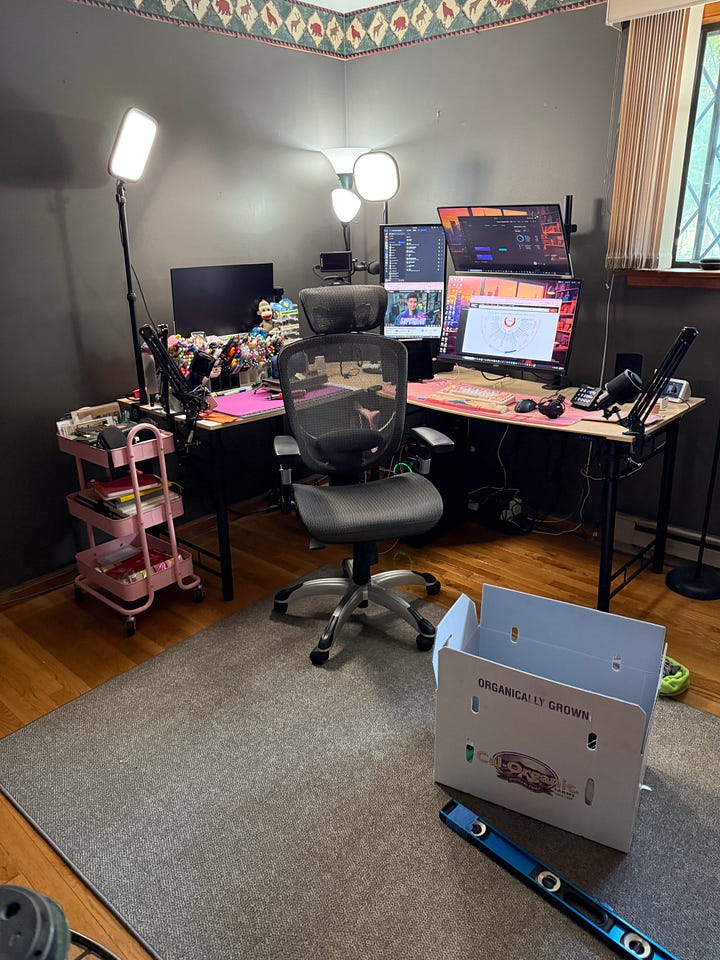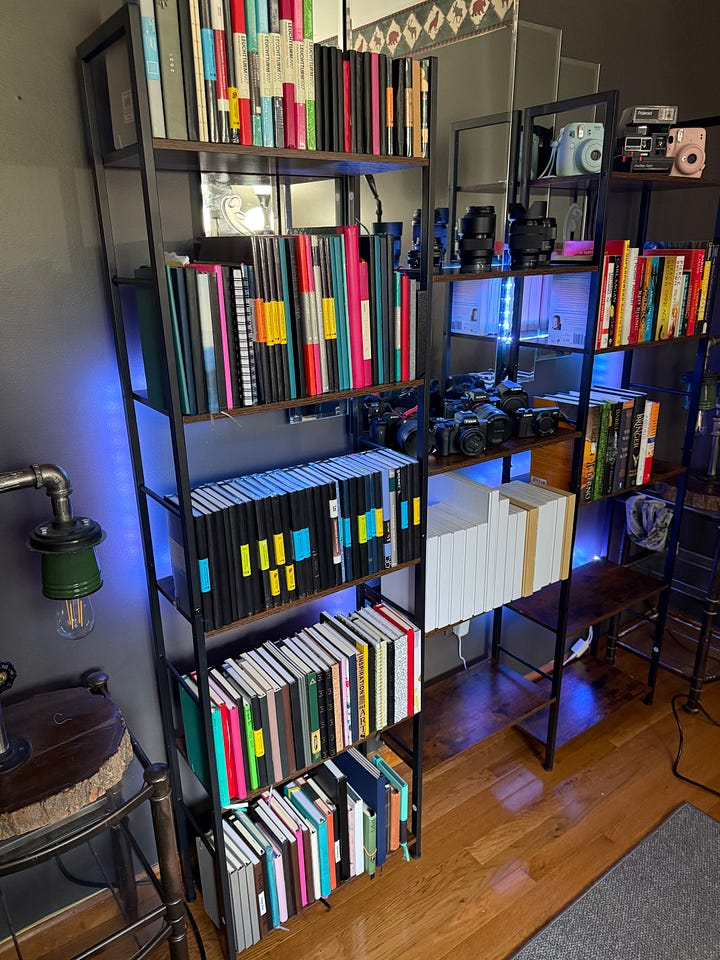A Room of One's Own: Why Creative Spaces Matter
How the Spaces We Shape, Shape the Art We Create
For most of my life, I never had the luxury of shaping a space entirely my own. Rooms were always shared or temporary. It felt like it never full reflected me. Recently, though, I moved into a new space and for the first time, I could decorate it exactly how I wanted from the ground up. Everything here is a reflection of my tastes, my rhythms, and my creative impulses. It excited me in a way I didn’t expect to be honest. As I was working on this space, I was just overcome with ideas. The same way any blank canvas opens up your world to possibilities, this room felt like it could be anything for me. And that’s when I really started to think about how important it is to have a creative space.
Having a creative space is not a frivolous indulgence. I believe it a necessity for cultivating the imagination, for mental well-being, and for nurturing the kind of consistency creativity thrives on. Our environments are not neutral backdrops. They influence how we think and what we make. Writers, artists, and inventors have always known this intuitively. I mean why else would so many of them have their sacred studies or studios? More so, in an ever increasing distraction saturated modern world, carving out a space dedicated to creativity is even more urgent.
I want to explore why creative spaces matter. We’re going to look a bit at the psychology of space and how environments influence focus and imagination. We’ll examine historical and cultural examples of creative rooms and studios. And we will also consider the mental health value of having a dedicated space to make things.
The Psychology of Space and Creativity
Humans are deeply affected by their environments, whether it’s conscious or not. The color of the walls, the level of noise, or even the clutter on a desk. All of these can nudge our minds toward or away from creative thinking. Psychologists have studied how context affects memory and cognition and one of the most striking findings is something called context dependent memory. Essentially, we recall information better in the same environment where we first learned it. If you studied vocabulary words in a quiet room, you’ll likely recall them better in another quiet room rather than in a noisy cafe. What does this mean for creativity? It means that physical cues in our space can act as triggers, priming the mind to enter creative flow. If you always sit at your desk with a particular notebook and a cup of tea to write, your brain begins to associate that setup with writing itself. The space becomes a shortcut to the creative state of mind. This is why rituals like lighting a candle, turning on a lamp, or even arranging your tools in a certain way, are so powerful. They transform a space from neutral into intentional.
Another dimension is the tension between clutter and minimalism. Some people thrive in messy studios, claiming the chaos sparks associations and unexpected connections. Others need clean surfaces and simplicity to feel free from distraction. There is no single formula. What matters is that the space matches your creative psychology. The key is awareness: notice how your environment is affecting your focus and imagination, then adjust intentionally. Even the sensory elements like lighting, sound, scent, play a role. Warm, diffuse lighting can relax the mind, while natural daylight energizes. Some creators need total silence while others thrive with background noise or music. Scents can act as anchors for creative states too. Whether it’s incense, a favorite candle, or even the smell of coffee. These aren’t superficial details. It all impacts you in ways you cant even explain.
The Emotional Value of A Creative Space
Beyond productivity, creative spaces serve a deeply emotional function. They are sanctuaries where vulnerability feels safe. To create is to expose something of yourself like your imagination, your fears, your desires. Doing that in a space you control helps lower the barriers of self-censorship. Think of a journal tucked away in a drawer. For many, that little notebook is a creative space in miniature. Within its pages, people confess thoughts they’d never speak aloud, sketch ideas without judgment, and process experiences. The notebook becomes a safe room, and the act of writing in it is inseparable from the space where it lives.
Mental health research increasingly points to the importance of boundaries for emotional well being. A creative space enforces boundaries not just against external interruptions but against the internal voice that says you should be “productive” in other ways. When you sit at your desk to paint, you are declaring, “This is creative time.” The space protects that identity. Even the smallest creative spaces, like a decorated corner in a shared apartment, carry this value. They serve as reminders that creativity matters, that amidst the chaos of life, there is a place where you can return to yourself.
Historical Examples
History is full of reminders that creative people have always needed, and often fiercely defended, their own spaces. Virginia Woolf wrote one of the most enduring essays on this subject, A Room of One’s Own. Woolf argued that for a woman to write fiction, she must have money and “a room of her own.” At the time, this was revolutionary. Women were often expected to create while simultaneously managing households, raising children, and being constantly available to others. Privacy was a privilege they were rarely afforded. Woolf’s essay pointed out a brutal truth: without space, both literal and metaphorical, women’s creative potential was stifled. Her insight wasn’t just about gender, it was about the universal need for freedom and autonomy in creative work. A room of one’s own symbolizes more than four walls. It represents the boundary between the world’s demands and the mind’s ability to wander freely.
Leonardo da Vinci’s creative spaces were almost mythical in their richness. Historical accounts describe his studios as half laboratory, half workshop, and half gallery. A place overflowing with sketches, canvases, sculptures in progress, anatomical models, and inventions that blurred the line between science and art. His notebooks, which survive in fragments, capture the same energy. Diagrams of flying machines drawn alongside studies of human muscles and engineering designs. For Leonardo, space was more than a room. It was an ecosystem. He needed physical areas where experiments could happen, where failures could pile up in the corner, and where imagination could leap from discipline to discipline without restriction. His studio embodied his polymathic curiosity. It wasn’t tidy or minimalistic. It was vibrant, crowded, and alive with possibility.
For modern creators, Leonardo’s example shows that creative spaces can thrive on abundance, on welcoming multiple interests into one place. Just as Virginia Woolf shows us the necessity of private freedom, Leonardo da Vinci shows us the power of a space designed to mirror curiosity itself.
Designing Your Own Space
The beauty of a creative space is that it doesn’t have to be grand. Not everyone has a spare room to convert into a studio. What matters is intentionality. If you live in a small apartment, a single desk can suffice if you arrange it with care. Choose objects that inspire you: a favorite mug, a plant, a piece of art. Lighting matters enormously. Consider a lamp with warm tones for evening work, or position your desk by a window for natural light.
Personalization is key. A creative space should reflect who you are. Some people fill their walls with mood boards, sketches, and photographs. Others prefer clean minimalism to allow the mind to wander freely. The goal is not to imitate someone else’s Pinterest aesthetic but to ask: what environment makes me feel most ready to create? Low-budget setups can be just as powerful. A thrifted desk, repurposed jars for pens, or DIY shelves can turn a corner into a sanctuary. What matters is the association you build between the space and your creative work.
Rituals anchor these spaces further. Brewing tea before journaling, playing a specific playlist before painting, or tidying the desk at the end of each session. These small habits transform space into practice. They tell the brain: we’re crossing the threshold into creativity.
Conclusion
Moving into my new space has shown me how much the environment matters. Not just in the aesthetic sense, but in how it shapes who I am when I enter it. For the first time, I feel like I have a sanctuary where my creativity is not squeezed into leftover corners of my life but invited to take center stage. And in recognizing that, I’ve come to understand that having a creative space is not a privilege reserved for the few but instead it’s a form of self-respect we all deserve.
A creative space does more than house notebooks and brushes. It houses us. Our ideas. Our vulnerabilities. Our experiments. Our failures. It gives imagination a safe place to stretch without fear of interruption or judgment. And perhaps most importantly, it reminds us that creativity is not an afterthought. It is essential, a core part of what it means to be human.
So if you haven’t already, claim your space. It doesn’t need to be perfect. It doesn’t need to be large. It just needs to be yours. Place a chair in a corner, line up your tools, light a candle, open the page. The world will always demand your time and energy but your creative self needs a home too. And when you give it one, you’ll be surprised how much more freely your imagination begins to breathe.
Because in the end, the importance of having a creative space is simple: it’s where we finally allow ourselves to create not out of pressure, but out of joy.


It’s coming together. Slowly but surely…



One of my favourite past times is to look up the studios and desktops of my favourite artists and authors for context. I often walk away feeling a bit more connected to their work.
A cozy and insightful read. Thank you.